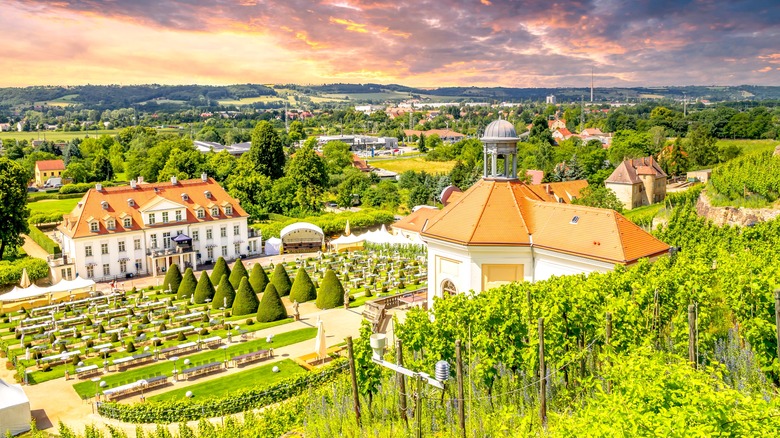'Europe's First-Ever Adventure Winery' Is A Breathtaking Castle In Germany's Scenic Countryside
Wineries are interesting, but unless you're a wine snob, they all start to feel the same after a little while. Sure, there are stunning views and delicious drinks, but it's hard to find something unique unless you visit under-the-radar wine regions that deserve the same hype as Napa. That's where the Wackerbarth Castle comes in, changing the game with an adventure and destination winery. Located in Germany, a mass producer of wines such as Rieslings and home to one of the world's best-ranked destinations for solo travel, Wackerbarth specializes in "cool climate" wines and sparkling beverages. It goes far to show what makes the wines in this area so distinct and to make sure you remember your trip fondly.
Though Wackerbarth Castle is the first-ever adventure winery, it's not a new business by any means. It's the second oldest sparkling wine factory in the country, going strong for nearly 200 years. The castle was built in the 18th century, between 1727 and 1730 by August Christoph Graf von Wackerbarth. Since then, it has switched ownership at least 20 times.
Wackerbarth stays local, only using local Saxon grapes that ferment inside the bottle. The winery is an incredibly popular destination, with more than 190,000 guests a year exploring the land. It also prides itself on the unique flavor of its wine, attributed to the cold climate that holds the distinct taste of the grapes well as it comes time to harvest.
What makes Wackerbarth Castle a destination winery?
This winery is different for a few reasons. For one, guests have the chance to watch the process up close and personal on multiple tours throughout the week. While exploring the castle, they can watch the cellar master do their daily work and learn more about the secrets of winemaking. Guests are able to try some of the available wines, both still and sparkling, and the castle also has a restaurant offering delicious meals that are worth trying out while you're there.
The tours are open all year long, though they're best taken between April and December when there are more time slots available. From January through March, there are tours once per day, and on Mondays there are none at all. The castle also has a separate sparkling wine tour; these are available on weekends from January to March, or every day between April and December. This tour goes into detail on how sparkling wines are made and offers a tasting at the end.
Of course, the Wackerbarth offers much more than just tours, drinks, and good food. Throughout the year, there are hikes, wine pairings with chocolate and cheese, music, ballet, readings, Christmas markets, festivals, and the availability to book the castle for all sorts of events, including weddings and conferences. Being in Germany, most of the tours are in German; however, if you give the hotel enough notice, they offer English translation devices so you can collect as much information about the winery and history as possible. It's still recommended you learn at least a little German before visiting, though, especially if you want to be able to ask questions and talk freely with your guide.
How to get to Wackerbarth Castle
Wackerbarth Castle is in Radebeul, Germany, a town between the more well-known Dresden and Meissen in the Saxon Elbeland. It's pretty easy to get to, as there are plenty of signs. All you have to do is follow them to Radebeul, whether you're coming from Dresden or Meissen. If you do happen to miss them, look for freeway exits Dresden Wilder Mann or Dresden Altstadt, as either of these will work. Then, once in the town, you just need to follow signs for Wackerbarth Castle, or 'Schloss Wackerbarth' as it will appear on local signage.
If you're using the wonderful public transportation common in European countries, it will also bring you fairly close to the castle. You'll just need to find a railway that goes to Kötzschenbroda or take a streetcar line to take you to Radebeul West/Flemmingstraße. Both will require a little bit of walking to reach the winery itself, but nothing too strenuous. It may sound complicated, but once you know the stops you're looking for, you'll see how easy it actually is.
When you're done at Wackerbarth Castle, you don't have to leave town right away, as there are plenty of other attractions worth keeping you in the area. If you are a fan of German writing, the museum dedicated to author Karl May is a must-visit. There is also the Spitzhaus Staircase and the Bismark Tower; the staircase leads up to the Spitzhaus, the oldest summer house in Lößnitz, which has been converted to be a restaurant. Next to the stairs is the Bismark Tower, or the Tower of Youth, built in honor of German Chancellor Prince Otto von Bismarck in the early 1900s. When you are done in Radebeul, you can explore the rest of Saxony, including destinations like Moritzburg Castle, a 16th-century hunting lodge turned fairytale palace.


